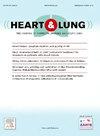重症监护病房出院后第一天的症状:一项横断面研究
IF 2.6
4区 医学
Q2 CARDIAC & CARDIOVASCULAR SYSTEMS
引用次数: 0
摘要
背景:关于重症监护病房(ICU)患者出院后症状经历的数据很少。目的了解症状的患病率、频率、严重程度和痛苦程度,并探讨可能的预测人口学和临床因素是否与ICU出院后第一天出现大量症状有关。方法在挪威的一项横断面研究中,使用纪念症状评估量表对32例成人ICU幸存者进行症状评估。收集了患病率(是/否)、频率和严重程度(4分制)以及困扰(5分制)的数据。使用逻辑回归分析分析了所选的预测人口学和临床因素与症状数量多(即≥12)之间可能存在的关联。结果155例患者报告的症状中位数为12种(范围0-22)。缺乏能量和口干是最常见的(83%)。最常见的症状是缺乏活力、口干和睡眠困难(中位数=4)。性兴趣/活动问题(中位数=3.5)、精力不足、口干、睡眠困难、疼痛、呕吐、感到悲伤和担忧是最严重的问题(中位数=3),而性兴趣/活动问题(中位数=4)、睡眠困难、呕吐、感到悲伤和担忧(中位数=3)是最令人痛苦的问题。住院外科病房的患者报告大量症状的可能性是住院内科病房的两倍多(OR=2.23;95% CI [1.08,4.63]) (p=0.031)。结论一半的ICU存活者在出院后第一天自述症状≥12种。最普遍的症状并不是最痛苦的,这突出表明需要筛查多种症状和维度,以提供目标症状缓解和优化康复。本文章由计算机程序翻译,如有差异,请以英文原文为准。
Symptoms on the first day after discharge from the intensive care unit:A cross-sectional study
Background
Data on intensive care unit (ICU) patients’ symptom experiences shortly after ICU discharge are scarce.
Objectives
To determine prevalence, frequency, severity and distress of symptoms, and to investigate if possible predictive demographic and clinical factors are associated with a high number of symptoms the first day after ICU discharge.
Methods
In a cross-sectional study in Norway, thirty-two symptoms were evaluated in adult ICU survivors using the Memorial Symptom Assessment Scale. Data on prevalence (yes/no), frequency and severity (4-point scales) and distress (5-point scales) were collected. Possible associations between selected predictive demographic and clinical factors and having a high number (i.e.≥12) of symptoms were analysed using logistic regression analyses.
Results
The patients (n=155) reported a median of 12 symptoms (range:0–22). Lack of energy and dry mouth were most prevalent (83%). Lack of energy, dry mouth, and difficulty sleeping were most frequent (median=4). Problems with sexual interest/activity (median=3.5), lack of energy, dry mouth, difficulty sleeping, pain, vomiting, feeling sad and worrying were most severe (median=3), and problems with sexual interest/activity (median=4), difficulty sleeping, vomiting, feeling sad and worrying (median=3) were most distressing. Patients admitted to surgical wards were more than twice as likely to report a high number of symptoms (OR=2.23;95% CI [1.08,4.63]) than those admitted to medical wards (p=0.031).
Conclusions
Half of ICU survivors self-reported ≥12 symptoms the first day after ICU discharge. The most prevalent symptoms were not the most distressful, highlighting the need to screen for multiple symptoms and dimensions to provide target symptom relief and optimize rehabilitation.
求助全文
通过发布文献求助,成功后即可免费获取论文全文。
去求助
来源期刊

Heart & Lung
医学-呼吸系统
CiteScore
4.60
自引率
3.60%
发文量
184
审稿时长
35 days
期刊介绍:
Heart & Lung: The Journal of Cardiopulmonary and Acute Care, the official publication of The American Association of Heart Failure Nurses, presents original, peer-reviewed articles on techniques, advances, investigations, and observations related to the care of patients with acute and critical illness and patients with chronic cardiac or pulmonary disorders.
The Journal''s acute care articles focus on the care of hospitalized patients, including those in the critical and acute care settings. Because most patients who are hospitalized in acute and critical care settings have chronic conditions, we are also interested in the chronically critically ill, the care of patients with chronic cardiopulmonary disorders, their rehabilitation, and disease prevention. The Journal''s heart failure articles focus on all aspects of the care of patients with this condition. Manuscripts that are relevant to populations across the human lifespan are welcome.
 求助内容:
求助内容: 应助结果提醒方式:
应助结果提醒方式:


